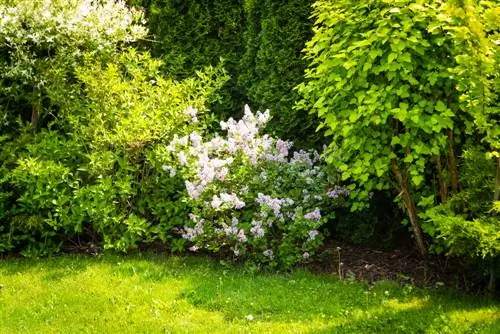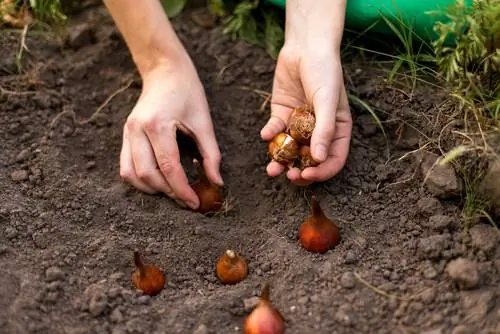- Author admin [email protected].
- Public 2023-12-16 16:46.
- Last modified 2025-06-01 06:02.
The intensely fragrant, white or purple flower spikes, profusely emerging from a bush or tree, are definitely part of spring. Lilac blossoms are a wonderful sight and delight the viewer every year - but only if care was taken to ensure suitable soil and a sunny location when planting them. In this article we will tell you how to plant lilacs correctly and what else you should pay attention to.

How to plant lilacs correctly?
To plant lilacs correctly, pay attention to a sunny location, well-drained, calcareous and nutrient-rich soil and the correct planting distance of 1.5-5 meters. Plant the lilac in autumn or spring and water it heavily.
Which location does lilac prefer?
The ideal location for lilacs is sunny - the more sun the plant gets, the more luxuriantly it blooms and the denser its crown grows. The shrub needs at least six hours of full sun a day to feel comfortable. In principle, you can also plant it in a shady place, but then it will not be as dense and will develop fewer flowers. The location should also be airy, unlike many other shrubs, lilacs tolerate wind very well and can therefore be planted well as a windbreak.
What should the optimal soil for lilacs be like?
Although lilacs do well on almost all soils, as long as they are not too heavy and wet, they still prefer well-drained, calcareous and nutrient-rich soils. A pH value between five and seven is ideal, although you can improve soil that is too acidic with lime. Nutrient-poor soil, on the other hand, should be improved with compost, topsoil and/or horn shavings (€52.00 on Amazon).
When is the best time to plant lilacs?
You plant container goods either in autumn - preferably between September and November - or in spring. However, autumn plantings will bloom the next spring because they have had enough time to take root. On the other hand, you should only plant bare-rooted lilacs when vegetation is dormant.
At what distance should you plant lilacs?
Lilac is a typical shallow-rooted plant whose network of roots spreads out in a wide radius around the trunk. The root disc usually has the same or even a slightly larger diameter than the crown. Since many lilac varieties can grow up to seven meters high (and several meters wide), a distance of between 1.5 to five meters is recommended, depending on the type and variety selected. This planting distance applies not only to other trees, but also to house walls, walls, etc. - lilac roots are very strong and can damage buildings.
How to plant lilacs in the garden - step by step?
When planting lilacs, it is best to proceed as follows:
- Find a suitable location in the garden.
- Dig a sufficiently large planting hole there.
- This should be at least twice as wide and deep as the root ball.
- Place the root ball in a bucket filled with water.
- The roots should soak up plenty of water.
- Alternatively, you can also fill the planting hole with water and wait until it has seeped away.
- Mix the excavated material with compost and horn shavings.
- Place the lilac in the ground and fill in the mixed excavation.
- Tread the earth firmly.
- Water the freshly planted lilac vigorously.
Watering makes it easier for the plant to grow in the soil; too little water in this phase quickly leads to drying out symptoms such as leaves turning yellow.
Can you also cultivate a lilac tree in a pot?
This question cannot be answered in such a general way. Most types and varieties of lilacs are not suitable for container cultivation as they can become very tall and wide with age. However, there are dwarf varieties that only grow to around two (or less) meters high and can be kept in sufficiently large pots. However, every lilac feels most comfortable in the garden.
How do you move an old lilac tree?
Transplanting an old lilac is problematic and often leads to failure: True to the old saying that you can't move an old tree, these specimens often die afterwards. However, you will have more success with younger lilacs that have been in the same location for a maximum of five years. Pay attention to the following information:
- Transplanting only in spring
- Cut back lilacs thoroughly before transplanting
- Dig up roots over as large an area as possible
- then water just as vigorously
When does lilac bloom?
Lilacs bloom in the wonderful month of May.
How can you propagate lilacs yourself?
Lilac can be propagated very well via cuttings or cuttings. Propagation via seeds that ripen in capsule fruits is also possible.
Which plants do lilacs best socialize with?
Good neighbors for lilacs are other flowering trees, either with a similar flowering period (cluster pine, fragrant jasmine, weigela, crabapple) or a later flowering period (hibiscus, hydrangeas, roses). However, the tree disc of the lilac should always remain free; the shallow-rooted plant does not tolerate underplanting very well.
Tip
If an old lilac has died due to disease or something similar, you will have to find a different location for a new shrub or tree - lilacs are incompatible with themselves, which is why planting them in the same location will cause infection with wilt. Bacteria can result.






